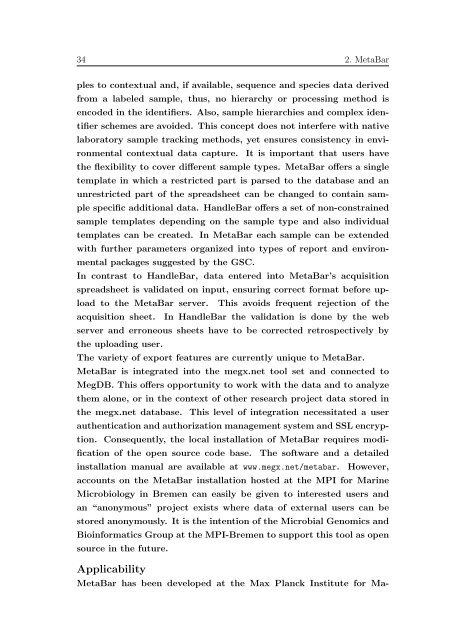Data integration in microbial genomics ... - Jacobs University
Data integration in microbial genomics ... - Jacobs University
Data integration in microbial genomics ... - Jacobs University
Create successful ePaper yourself
Turn your PDF publications into a flip-book with our unique Google optimized e-Paper software.
34 2. MetaBar<br />
ples to contextual and, if available, sequence and species data derived<br />
from a labeled sample, thus, no hierarchy or process<strong>in</strong>g method is<br />
encoded <strong>in</strong> the identifiers. Also, sample hierarchies and complex identifier<br />
schemes are avoided. This concept does not <strong>in</strong>terfere with native<br />
laboratory sample track<strong>in</strong>g methods, yet ensures consistency <strong>in</strong> environmental<br />
contextual data capture. It is important that users have<br />
the flexibility to cover different sample types. MetaBar offers a s<strong>in</strong>gle<br />
template <strong>in</strong> which a restricted part is parsed to the database and an<br />
unrestricted part of the spreadsheet can be changed to conta<strong>in</strong> sample<br />
specific additional data. HandleBar offers a set of non-constra<strong>in</strong>ed<br />
sample templates depend<strong>in</strong>g on the sample type and also <strong>in</strong>dividual<br />
templates can be created. In MetaBar each sample can be extended<br />
with further parameters organized <strong>in</strong>to types of report and environmental<br />
packages suggested by the GSC.<br />
In contrast to HandleBar, data entered <strong>in</strong>to MetaBar’s acquisition<br />
spreadsheet is validated on <strong>in</strong>put, ensur<strong>in</strong>g correct format before upload<br />
to the MetaBar server. This avoids frequent rejection of the<br />
acquisition sheet. In HandleBar the validation is done by the web<br />
server and erroneous sheets have to be corrected retrospectively by<br />
the upload<strong>in</strong>g user.<br />
The variety of export features are currently unique to MetaBar.<br />
MetaBar is <strong>in</strong>tegrated <strong>in</strong>to the megx.net tool set and connected to<br />
MegDB. This offers opportunity to work with the data and to analyze<br />
them alone, or <strong>in</strong> the context of other research project data stored <strong>in</strong><br />
the megx.net database. This level of <strong><strong>in</strong>tegration</strong> necessitated a user<br />
authentication and authorization management system and SSL encryption.<br />
Consequently, the local <strong>in</strong>stallation of MetaBar requires modification<br />
of the open source code base. The software and a detailed<br />
<strong>in</strong>stallation manual are available at www.megx.net/metabar. However,<br />
accounts on the MetaBar <strong>in</strong>stallation hosted at the MPI for Mar<strong>in</strong>e<br />
Microbiology <strong>in</strong> Bremen can easily be given to <strong>in</strong>terested users and<br />
an “anonymous” project exists where data of external users can be<br />
stored anonymously. It is the <strong>in</strong>tention of the Microbial Genomics and<br />
Bio<strong>in</strong>formatics Group at the MPI-Bremen to support this tool as open<br />
source <strong>in</strong> the future.<br />
Applicability<br />
MetaBar has been developed at the Max Planck Institute for Ma-

















